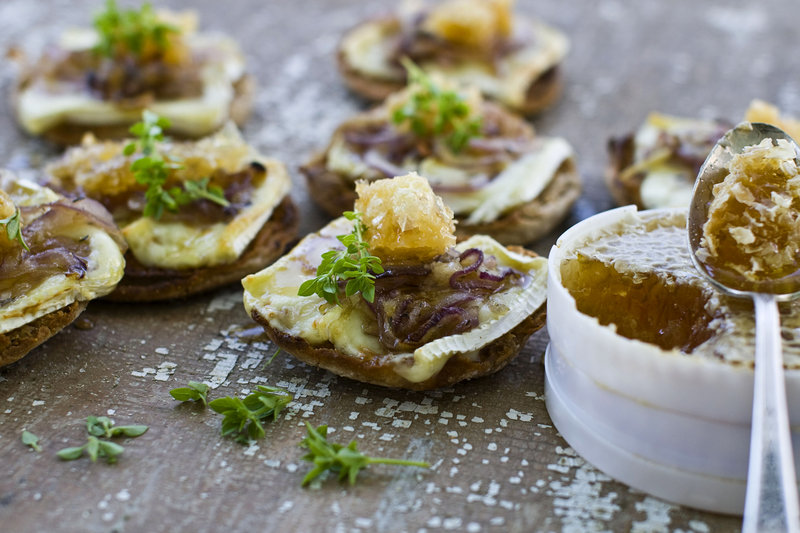It’s time to think beyond the bear bottle.
Because honey comes in way more forms than just plastic squirt bottles. My favorite? Honey in the comb, pure and simple.
And yes, the comb is totally safe to eat. People have been keeping bees – and eating the honeycomb — for several thousand years.
But first, some honey 101. No, honey is not bee spit. But bee saliva does play a role.
When bees gather nectar from flowers, it is stored in a honey sac inside their bodies. During storage, the bee’s saliva mixes with the nectar, which (shocker!) is made mostly from sugar. Enzymes in the saliva convert those sugars into honey.
The honeycomb comes into play when the bee gets back to the hive. The comb itself — a network of hexagonal cylinders — is made from the waxy secretions of worker bees. As these cylinders are filled with honey, they are capped with yet another layer of wax.
The bees do all this to create food for themselves. In fact, for every pound of honey gathered by people, the bees make and consume another eight.
Honey processors typically gather these wax combs, crush them and run them through a centrifuge to extract the liquid honey.
But increasingly, you can find tubs of unbroken honeycomb at grocers and farmers markets. It’s golden and waxy and sticky, and the easiest way to extract it from the tub usually is a fork or spoon.
Honeycomb is totally worth seeking out. Kids love it. It looks cool. It tastes great. And you get to amaze the little ones with facts such as the distance a bee would fly to produce just one pound of honey (three times around the Earth).
But after you’re done dazzling your kids with honey trivia, why bother with honeycomb when you could just squirt the liquid stuff from a plastic bear?
The answer is part textural, part versatility. Let’s start with the latter.
Honeycomb can go places honey can’t. While drizzling honey over a salad seems odd, topping a salad with crumbled goat cheese and hunks of honeycomb is a simply heavenly way to eat more vegetables.
Honeycomb also has a completely different texture than liquid honey. It’s not like chewing on a candle. Rather, the wax gives the honey a pleasant body, transforming it from something merely absorbed by the other ingredients into something that stands on its own to contrast and enliven the rest of the dish.
Like liquid honey, honeycomb can be stored at room temperature for long periods.
If you have a choice at the market, opt for darker colored honeycomb (and liquid honeys), which tend to have deeper flavors.
Ready to give it a try? For more ideas for using honeycomb, check out the Off the Beaten Aisle column on Food Network: http://bit.ly/JPXhCW
HONEYCOMB AND BRIE ENGLISH MUFFIN PIZZAS
This recipe calls for just a touch of heat under the broiler. It’s just enough to soften the brie and honeycomb, one of the most splendid food combinations.
Start to finish: 15 minutes
Servings: 4
1 tablespoon olive oil
1 medium red onion, thinly sliced
1 clove garlic, minced
1/2 teaspoon dried thyme
Salt and ground black pepper
4 large whole-wheat English muffins
6 ounces brie, thinly sliced
Honeycomb
Heat the oven to broil.
In a medium skillet over medium-high, heat the olive oil. Add the onion, garlic and thyme, then saute for 5 minutes, or until the onion starts to get tender.
Season with salt and pepper, then set aside.
Split each English muffin in half and arrange cut side up on a baking sheet. Set under the broiler just long enough to lightly toast, about 1 minute.
Top each muffin half with a bit of brie, then spoon a bit of the onion mixture over each. Place under the broiler for another minute.
Transfer the halves to serving plates, then top each with a spoonful of honeycomb. Serve immediately.
Send questions/comments to the editors.



Success. Please wait for the page to reload. If the page does not reload within 5 seconds, please refresh the page.
Enter your email and password to access comments.
Hi, to comment on stories you must . This profile is in addition to your subscription and website login.
Already have a commenting profile? .
Invalid username/password.
Please check your email to confirm and complete your registration.
Only subscribers are eligible to post comments. Please subscribe or login first for digital access. Here’s why.
Use the form below to reset your password. When you've submitted your account email, we will send an email with a reset code.